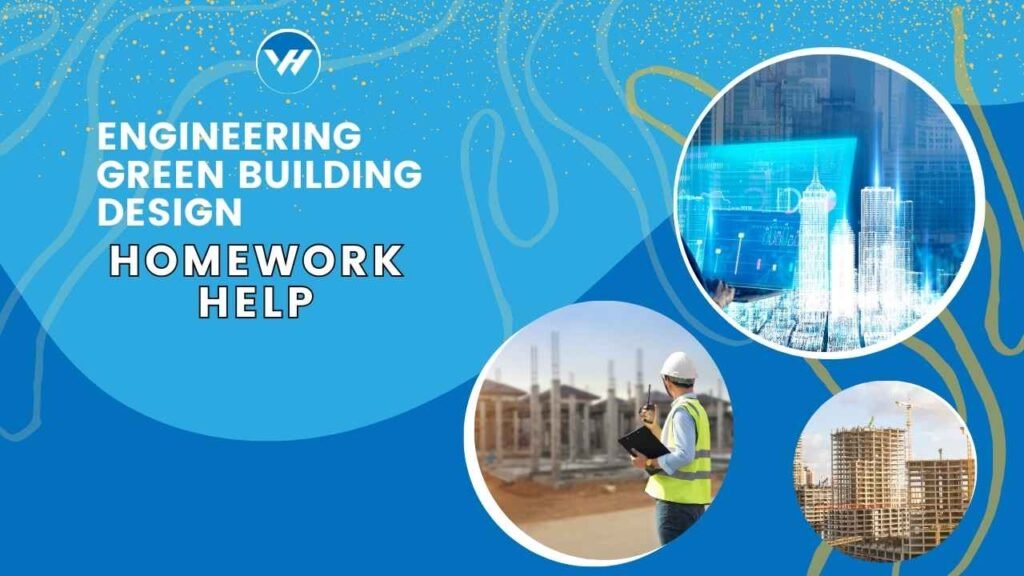When we talk about the future of construction, one concept stands out: green building design. This approach focuses on creating environmentally responsible and resource-efficient buildings. But why is green building design so important in engineering? Let’s dive in and explore.

Table of Contents
ToggleUnderstanding Green Building Design
Principles of Green Building Design
Green building design is all about sustainability. It aims to reduce the negative impact on the environment and enhance the health and well-being of occupants. This involves careful planning and the use of sustainable resources throughout a building’s lifecycle—from siting to design, construction, operation, maintenance, renovation, and demolition.
Benefits of Green Building Design
Environmental Benefits
Green buildings use less water, energy, and other resources, leading to significant reductions in carbon footprint and waste. They incorporate renewable energy sources, minimize pollution, and promote biodiversity, helping to combat climate change and preserve natural habitats.
Economic Benefits
Though initial costs may be higher, green buildings save money in the long run through reduced energy and water bills, lower maintenance costs, and improved property values. They often qualify for tax rebates, grants, and incentives, further offsetting the upfront investment.
Social Benefits
These buildings provide healthier living and working environments, enhancing the quality of life for occupants with better air quality, natural lighting, and temperature control. They contribute to the well-being of communities by creating spaces that are safe, comfortable, and conducive to productivity.
Key Components of Green Building Design
Sustainable Site Development
Choosing a site wisely and planning development to protect natural resources and ecosystems is crucial. This includes minimizing land disturbance, managing stormwater, and preserving natural landscapes.
Water Efficiency
Implementing systems that reduce water use and promote recycling helps conserve this precious resource. Strategies include low-flow fixtures, rainwater harvesting, and greywater systems for irrigation and other non-potable uses.
Energy Efficiency
Using renewable energy sources, improving insulation, and incorporating energy-efficient systems can dramatically reduce energy consumption. Buildings can integrate solar panels, wind turbines, and energy-efficient HVAC systems to lower their energy footprint.
Materials Selection
Opting for sustainable, recycled, or locally sourced materials reduces the environmental impact. Materials should be durable, non-toxic, and require minimal maintenance. Using reclaimed wood, recycled steel, and low-VOC paints are common practices.
Indoor Environmental Quality
Ensuring good air quality, adequate ventilation, and the use of non-toxic materials contributes to the health and comfort of occupants. Natural lighting, thermal comfort, and acoustic performance are also important factors in creating a pleasant indoor environment.
Green Building Certification Systems
LEED (Leadership in Energy and Environmental Design)
LEED is a widely used green building rating system. It provides a framework for healthy, efficient, and cost-saving green buildings. Projects earn points for various sustainable practices, achieving different certification levels based on their total score.
BREEAM (Building Research Establishment Environmental Assessment Method)
BREEAM is another leading method for assessing, rating, and certifying the sustainability of buildings. It covers various aspects such as energy, health and well-being, pollution, transportation, materials, waste, water, land use, and ecology.
Green Star
This rating system assesses the environmental impact of buildings in Australia and is gaining international recognition. It evaluates the design, construction, and operation of buildings, rewarding initiatives that improve sustainability and reduce environmental impact.
Challenges in Green Building Design
High Initial Costs
The upfront investment in sustainable technologies and materials can be significant, which may deter some developers. However, the long-term savings and benefits often justify the initial expense.
Lack of Awareness
Many people are still unaware of the benefits and methods of green building design, which can slow adoption. Education and advocacy are essential to increase awareness and drive the demand for sustainable buildings.
Technical Challenges
Implementing green building practices requires specialized knowledge and expertise, which can be a barrier for some projects. Continuous professional development and training are necessary to keep up with the latest advancements in sustainable construction.
Role of Engineers in Green Building Design
Conceptualization and Planning
Engineers play a crucial role in the early stages of green building design, ensuring that sustainability is integrated from the start. They collaborate with architects and planners to create efficient, sustainable, and functional designs.
Implementation and Construction
They oversee the construction process, making sure that sustainable practices are followed. This includes managing resources, reducing waste, and ensuring that all systems are installed correctly and operate efficiently.
Maintenance and Operations
Ongoing maintenance and operations must align with green building principles to ensure long-term sustainability. Engineers develop maintenance plans and monitor building performance to identify areas for improvement and optimization.
Common Topics in Green Building Design Homework
Energy Modeling and Simulation
This involves predicting a building’s energy consumption and identifying ways to reduce it. Students learn to use software tools to model energy use and explore strategies for improving energy efficiency.
Sustainable Materials Selection
Choosing materials that are sustainable and have a low environmental impact is a common topic. Assignments may involve evaluating different materials based on their life cycle, durability, and environmental footprint.
Waste Management Plans
Effective waste management strategies are essential in green building design. Students might develop plans for reducing, reusing, and recycling construction waste, as well as managing waste during the building’s operation.
Water Conservation Strategies
These include techniques for reducing water usage and recycling wastewater. Assignments may focus on designing systems for rainwater harvesting, greywater reuse, and implementing water-efficient fixtures.
How to Approach Green Building Design Assignments
Understanding the Requirements
Make sure you thoroughly understand the assignment requirements and objectives. Review the guidelines, deadlines, and any specific criteria provided by your instructor.
Conducting Research
Research is crucial. Look for reliable sources and stay updated with the latest trends and technologies in green building design. Use academic journals, industry reports, and credible websites to gather information.
Developing a Design Proposal
Create a detailed design proposal that outlines your approach and solutions. Include sketches, diagrams, and calculations to support your design.
Presenting the Design
Clearly and effectively present your design, using visuals and data to support your ideas. Practice your presentation skills and be prepared to answer questions and defend your design choices.
Tools and Software for Green Building Design
EnergyPlus
This tool helps simulate building energy consumption, allowing designers to test different energy-saving measures and optimize building performance.
AutoCAD
A widely used software for drafting and designing building plans. It allows for precise and detailed drawings, which are essential in the planning and construction phases.
Revit
This software supports building information modeling (BIM), allowing for detailed design and analysis. It integrates various aspects of design, construction, and maintenance into a single platform.
DesignBuilder
An integrated platform for energy, carbon, and comfort analysis. It helps designers evaluate the performance of buildings and identify opportunities for improvement.
Tips for Excelling in Green Building Design Homework
Stay Updated with Industry Trends
The field of green building design is constantly evolving. Stay informed about new technologies, materials, and practices through industry publications, conferences, and webinars.
Collaborate with Peers
Working with classmates can provide new insights and ideas. Form study groups, share resources, and provide feedback on each other’s work.
Seek Feedback from Professors
Regular feedback helps improve your work and understanding. Don’t hesitate to ask questions and seek clarification on assignments.
Utilize Online Resources
Many online resources, such as webinars, forums, and articles, can enhance your knowledge. Websites like the US Green Building Council and the World Green Building Council offer valuable information and case studies.
Virtual Help for Green Building Design Assignments
Overview of Virtual Help
Virtual Help is an online platform that connects students with expert tutors for assignment assistance. It offers a convenient way to get personalized help and improve your understanding of complex topics.
Features of the Virtual Help Platform
The platform offers personalized tutoring, 24/7 availability, and a wide range of subjects. It also provides resources such as study guides, practice problems, and interactive learning tools.
How to Use Virtual Help for Green Building Design Homework
Simply download the Virtual Help app, create an account, and connect with a tutor specializing in green building design. You can schedule sessions, submit assignments for review, and get feedback from experts.
Benefits of Using Virtual Help
Access to Expert Tutors
Get guidance from experts in green building design who can help clarify concepts and improve your assignments. Tutors have industry experience and can provide practical insights.
Personalized Assistance
Tutors provide tailored help based on your specific needs and challenges. They can help you understand difficult concepts, review your work, and provide constructive feedback.
Flexible Learning Options
Study at your own pace and on your schedule. Virtual Help offers flexible tutoring options, so you can get help when you need it, whether it’s late at night or early in the morning.
Comprehensive Resources
Access a wealth of resources, including study materials, practice problems, and more. Virtual Help provides a variety of learning tools to support your studies.
Conclusion
Green building design is an exciting and essential field in engineering, focusing on sustainability and efficiency. Whether you’re tackling a homework assignment or planning a career in this area, understanding the principles and staying updated with industry trends is crucial. Utilizing resources like Virtual Help can provide the support you need to excel in your studies and future career.
FAQs
What is green building design?
Green building design is an approach to constructing buildings that are environmentally responsible and resource-efficient throughout their lifecycle.
Why is green building design important?
It helps reduce the environmental impact of buildings, improves the health and well-being of occupants, and provides economic benefits through cost savings and increased property values.
What are some common green building certification systems?
LEED, BREEAM, and Green Star are popular systems that assess and certify the sustainability of buildings.
What tools are used in green building design?
EnergyPlus, AutoCAD, Revit, and DesignBuilder are some of the tools used for modeling, designing, and analyzing green buildings.
How can Virtual Help assist with green building design homework?
Virtual Help connects students with expert tutors who provide personalized assistance, helping with understanding concepts, reviewing assignments, and offering feedback.





